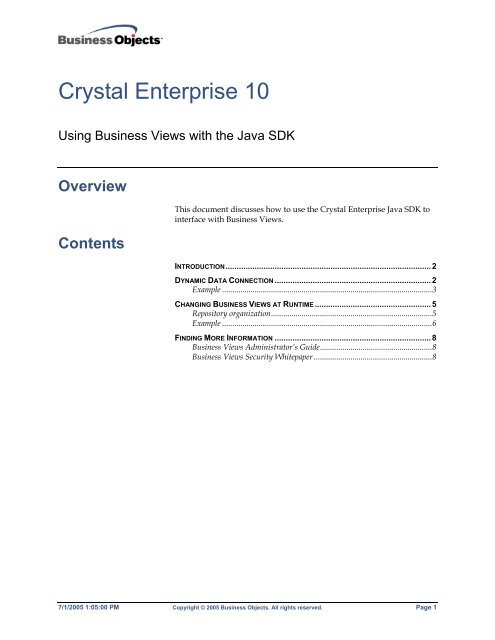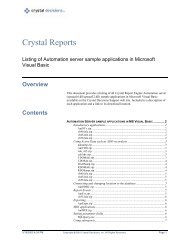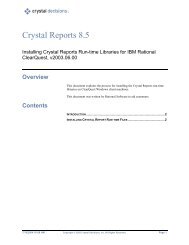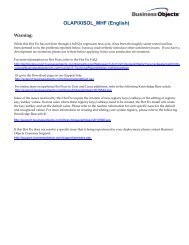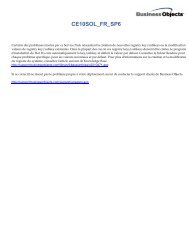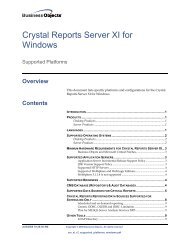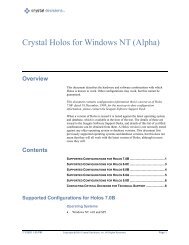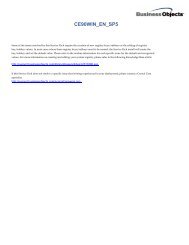Crystal Enterprise 10 - SAP Developer Network
Crystal Enterprise 10 - SAP Developer Network
Crystal Enterprise 10 - SAP Developer Network
You also want an ePaper? Increase the reach of your titles
YUMPU automatically turns print PDFs into web optimized ePapers that Google loves.
<strong>Crystal</strong> <strong>Enterprise</strong> <strong>10</strong><br />
Using Business Views with the Java SDK<br />
Overview<br />
Contents<br />
This document discusses how to use the <strong>Crystal</strong> <strong>Enterprise</strong> Java SDK to<br />
interface with Business Views.<br />
INTRODUCTION............................................................................................ 2<br />
DYNAMIC DATA CONNECTION ......................................................................2<br />
Example .......................................................................................................3<br />
CHANGING BUSINESS VIEWS AT RUNTIME ....................................................5<br />
Repository organization...............................................................................5<br />
Example .......................................................................................................6<br />
FINDING MORE INFORMATION ......................................................................8<br />
Business Views Administrator’s Guide.......................................................8<br />
Business Views Security Whitepaper ..........................................................8<br />
7/1/2005 1:05:00 PM Copyright © 2005 Business Objects. All rights reserved. Page 1
<strong>Crystal</strong> <strong>Enterprise</strong> <strong>10</strong> Using Business Views with the Java SDK<br />
Introduction<br />
Dynamic Data Connection<br />
NOTE<br />
Business Views is a new feature introduced in <strong>Crystal</strong> Reports <strong>10</strong> and<br />
<strong>Crystal</strong> <strong>Enterprise</strong> <strong>10</strong> that provides view time security. When viewing a<br />
report(s) based on a Business View, only the rows and columns that the<br />
current user is entitled to view are visible.<br />
This security model applies when not only viewing reports in <strong>Crystal</strong><br />
Reports but also when scheduling reports with saved data in <strong>Crystal</strong><br />
<strong>Enterprise</strong>. Business Views are stored in the <strong>Crystal</strong> <strong>Enterprise</strong> <strong>10</strong> <strong>Crystal</strong><br />
Management Server (CMS) Repository, along with other report design<br />
components.<br />
You are able to interact with Business Views in two ways using the<br />
<strong>Crystal</strong> <strong>Enterprise</strong> <strong>10</strong> Java SDK. With Dynamic Data Connections, you<br />
are able to change the data connection of a Business View by passing its<br />
Cluster Unique Identifier (CUID). You are also able to change the<br />
Business View to which a report is connected. This document discusses<br />
these two methods of interaction.<br />
Dynamic Data Connections consist of a collection of pointers to different<br />
data connections. By setting a parameter value, you are able to specify<br />
which data connection to use.<br />
A Dynamic Data Connection enables you to change between data<br />
sources as needed, whereas a data connection is more static. Therefore, a<br />
Dynamic Data Connection provides additional flexibility in terms of<br />
specifying a data source, but it is not a mandatory object when you<br />
create your Business View. You are able to create Data Foundations with<br />
or without using a Dynamic Data Connection.<br />
You must first create more than one data connection before you can create a Dynamic<br />
Data Connection.<br />
Many organizations use a development, test, and production system<br />
model for housing their data. That is, the data is initially stored on a<br />
development system and then later migrated to a test system. After<br />
extensive testing, the data in the test system is ready to be used in the<br />
production system. Dynamic Data Connections can serve this purpose.<br />
When a report is connected to a Dynamic Data Connection, a report<br />
parameter is automatically created. The parameter contains the same<br />
number of default values as data connections in the Dynamic Data<br />
Connection. Each of the values represents the CUID of the data<br />
connection in the Dynamic Data Connection. The parameter description<br />
is the name of the data connection. To connect to a specific data<br />
connection, the current value of the parameter must be set to the<br />
corresponding CUID.<br />
7/1/2005 1:05:00 PM Copyright © 2005 Business Objects. All rights reserved. Page 2<br />
ce<strong>10</strong>_using_business_views_with_java_sdk.pdf
<strong>Crystal</strong> <strong>Enterprise</strong> <strong>10</strong> Using Business Views with the Java SDK<br />
Example<br />
The following code demonstrates how to set the current value of the<br />
parameter to the CUID of the desired Data Connection:<br />
import com.crystaldecisions.sdk.occa.report.application.*;<br />
import com.crystaldecisions.sdk.occa.report.definition.*;<br />
import com.crystaldecisions.sdk.occa.report.data.*;<br />
import com.crystaldecisions.sdk.occa.report.lib.*;<br />
import com.crystaldecisions.sdk.framework.*;<br />
import com.crystaldecisions.sdk.occa.managedreports.*;<br />
import com.crystaldecisions.sdk.occa.infostore.*;<br />
import com.crystaldecisions.sdk.plugin.desktop.report.*;<br />
import com.crystaldecisions.sdk.plugin.desktop.common.*;<br />
import com.crystaldecisions.report.web.viewer.*;<br />
import<br />
com.crystaldecisions.sdk.occa.report.reportsource.IReportSo<br />
urce;<br />
import java.util.*;<br />
/* Connect to <strong>Crystal</strong> <strong>Enterprise</strong> */<br />
<strong>Crystal</strong><strong>Enterprise</strong> ce = new <strong>Crystal</strong><strong>Enterprise</strong>();<br />
ISessionMgr sm = ce.getSessionMgr();<br />
I<strong>Enterprise</strong>Session es = sm.logon(“cmsUser”, “cmsPassword”,<br />
“mAPSName”,<br />
“mAuthType”);<br />
/* Get the InfoStore service from <strong>Crystal</strong> <strong>Enterprise</strong> */<br />
IInfoStore infoStore = (IInfoStore)es.getService("",<br />
"InfoStore");<br />
/* Retrieve the report by name from <strong>Crystal</strong> <strong>Enterprise</strong> */<br />
IInfoObjects oInfoObjects = infoStore.query("Select * From<br />
CI_INFOOBJECTS<br />
Where SI_NAME = 'reportName'");<br />
/* Open the report into a Report Document object */<br />
IInfoObject oInfoObject = (IInfoObject)oInfoObjects.get(0);<br />
IReport report = (IReport)oInfoObject;<br />
/* create a new Fields collection to represent the report’s<br />
parameters */<br />
Fields params = new Fields();<br />
/* Get the old IReportParameter object */<br />
7/1/2005 1:05:00 PM Copyright © 2005 Business Objects. All rights reserved. Page 3<br />
ce<strong>10</strong>_using_business_views_with_java_sdk.pdf
<strong>Crystal</strong> <strong>Enterprise</strong> <strong>10</strong> Using Business Views with the Java SDK<br />
IReportParameter oldParam =<br />
(IReportParameter)report.getReportParameters().get(0);<br />
/* Convert the IReportParameter object to the<br />
ParameterField object that the viewer accepts */<br />
ParameterField newParamField =<br />
oldParam.getParameterField();<br />
/* Get the Description of the parameter value for<br />
demonstration purposes */<br />
String description =<br />
((IReportParameterSingleValue)oldParam.getDefaultValues().g<br />
et(0)).getDescription();<br />
out.println( "Parameter Value Description = " + description<br />
+ "" );<br />
ParameterFieldDiscreteValue newDiscreteValue =<br />
new ParameterFieldDiscreteValue();<br />
IReportParameterValues oldDefaultValues =<br />
(IReportParameterValues)oldParam.getDefaultValues();<br />
String CUIDofDataConnection0 =<br />
((IReportParameterSingleValue)oldDefaultValues.get(0)).getV<br />
alue();<br />
out.println( "CUID --> " + CUIDofDataConnection0 + ""<br />
);<br />
/* Pass the CUID of the Business View to the value object<br />
*/<br />
newDiscreteValue.setValue( CUIDofDataConnection0 );<br />
/* Pass the value object into the new Parameter Field */<br />
Values values = new Values();<br />
newParamField.setCurrentValues( values );<br />
newParamField.getCurrentValues().add( newDiscreteValue );<br />
out.println( "Currnet Values = " +<br />
((IParameterFieldDiscreteValue)newParamField.getCurrentValu<br />
es().getValue(0)).getValue() );<br />
/* Add the new parameter field to the collection of<br />
parameters */<br />
params.add( newParamField );<br />
/* Create a Report source object to pass to the Viewer */<br />
7/1/2005 1:05:00 PM Copyright © 2005 Business Objects. All rights reserved. Page 4<br />
ce<strong>10</strong>_using_business_views_with_java_sdk.pdf
<strong>Crystal</strong> <strong>Enterprise</strong> <strong>10</strong> Using Business Views with the Java SDK<br />
NOTE<br />
IReportSourceFactory factoryPS = (IReportSourceFactory)<br />
es.getService("PSReportFactory");<br />
IReportSource reportSource =<br />
factoryPS.openReportSource(oInfoObject,Locale.ENGLISH);<br />
/* View the Report */<br />
<strong>Crystal</strong>ReportViewer viewer = new <strong>Crystal</strong>ReportViewer();<br />
viewer.set<strong>Enterprise</strong>Logon(es);<br />
viewer.setReportSource( reportSource );<br />
viewer.setParameterFields( params );<br />
viewer.processHttpRequest(request, response,<br />
getServletConfig().getServletContext(), out);<br />
Changing Business Views at Runtime<br />
Refer to the <strong>Crystal</strong> Java <strong>Developer</strong>’s Library that is included on the <strong>Crystal</strong> <strong>Enterprise</strong> <strong>10</strong><br />
CD for more information.<br />
With the Report Application Server (RAS) SDK in <strong>Crystal</strong> <strong>Enterprise</strong> <strong>10</strong>,<br />
you are able to change a report’s Business View, as well as any of its<br />
implemented security constraints, at runtime. To change a Business View<br />
at runtime, the new Business View must be identical in schema, name,<br />
and number of Business Elements (see Table 1).<br />
Original Business View Destination Business View<br />
Business Element Employee Business Element Employee<br />
Business Element Customer Business Element Customer<br />
Table 1<br />
In the example in Table 1, the Employee Business Element in the original<br />
Business View is replaced by the Employee Business Element in the<br />
destination Business View. They are identical in name and number of<br />
elements.<br />
Repository organization<br />
To have multiple Business Elements with the same name in one<br />
repository system, the elements must be organized in separate folders.<br />
Each Business View should be stored in its own folder that contains all<br />
its Business Elements.<br />
7/1/2005 1:05:00 PM Copyright © 2005 Business Objects. All rights reserved. Page 5<br />
ce<strong>10</strong>_using_business_views_with_java_sdk.pdf
<strong>Crystal</strong> <strong>Enterprise</strong> <strong>10</strong> Using Business Views with the Java SDK<br />
Example<br />
The following code demonstrates how to change a report’s Business<br />
View at runtime:<br />
import com.crystaldecisions.sdk.occa.infostore.*;<br />
import com.crystaldecisions.sdk.framework.*;<br />
import com.crystaldecisions.sdk.occa.report.application.*;<br />
import com.crystaldecisions.sdk.occa.report.definition.*;<br />
import com.crystaldecisions.sdk.occa.report.data.*;<br />
import com.crystaldecisions.sdk.occa.report.lib.*;<br />
import com.crystaldecisions.sdk.occa.managedreports.*;<br />
import<br />
com.crystaldecisions.report.web.viewer.<strong>Crystal</strong>ReportViewer;<br />
import java.util.*;<br />
/* Login to <strong>Crystal</strong> <strong>Enterprise</strong> and retrieve a Session */<br />
I<strong>Enterprise</strong>Session es =<br />
<strong>Crystal</strong><strong>Enterprise</strong>.getSessionMgr().logon( “cmsuser”,<br />
“cmspassword”, “CMSName”, “cmsAuthType” );<br />
/* Retrieve a RAS report service */<br />
IReportAppFactory rptAppFactory =<br />
(IReportAppFactory)es.getService("", "RASReportService");<br />
/* Get the InfoStore service from <strong>Crystal</strong> <strong>Enterprise</strong> */<br />
IInfoStore infoStore = (IInfoStore)es.getService("",<br />
"InfoStore");<br />
/* Retrieve the report by name from <strong>Crystal</strong> <strong>Enterprise</strong> */<br />
IInfoObjects oInfoObjects = infoStore.query("Select SI_ID<br />
From CI_INFOOBJECTS<br />
Where SI_NAME = 'reportName'");<br />
/* Convert the report into a Report Document object */<br />
ReportClientDocument clientDoc =<br />
rptAppFactory.openDocument((IInfoObject)oInfoObjects.get(0)<br />
, 0, Locale.ENGLISH);<br />
/* Retrieve the DatabaseController */<br />
DatabaseController oDatabaseController =<br />
clientDoc.getDatabaseController();<br />
7/1/2005 1:05:00 PM Copyright © 2005 Business Objects. All rights reserved. Page 6<br />
ce<strong>10</strong>_using_business_views_with_java_sdk.pdf
<strong>Crystal</strong> <strong>Enterprise</strong> <strong>10</strong> Using Business Views with the Java SDK<br />
/* Retrieve the 'Xtreme Production Business View' */<br />
String query = "SELECT SI_CUID FROM CI_APPOBJECTS WHERE<br />
SI_NAME =<br />
'VisNetView' ";<br />
oInfoObjects = null;<br />
oInfoObjects = infoStore.query(query);<br />
IInfoObject oBusinessView =<br />
(IInfoObject)oInfoObjects.get(0);<br />
/* Set the datasource to another Business View */<br />
oDatabaseController.setDataSource( oBusinessView );<br />
/* View the report */<br />
<strong>Crystal</strong>ReportViewer viewer = new <strong>Crystal</strong>ReportViewer();<br />
viewer.set<strong>Enterprise</strong>Logon(es);<br />
viewer.setName("<strong>Crystal</strong>_Report_Viewer");<br />
viewer.setOwnPage(true);<br />
viewer.setReportSource(clientDoc.getReportSource() );<br />
viewer.processHttpRequest(request, response,<br />
getServletConfig().getServletContext, out);<br />
NOTE Refer to the <strong>Crystal</strong> Java <strong>Developer</strong>’s Library that is included on the <strong>Crystal</strong> <strong>Enterprise</strong> <strong>10</strong><br />
CD for more information.<br />
7/1/2005 1:05:00 PM Copyright © 2005 Business Objects. All rights reserved. Page 7<br />
ce<strong>10</strong>_using_business_views_with_java_sdk.pdf
<strong>Crystal</strong> <strong>Enterprise</strong> <strong>10</strong> Using Business Views with the Java SDK<br />
Finding More Information<br />
Business Views Administrator’s Guide<br />
http://support.businessobjects.com/communityCS/TechnicalPapers/ce<br />
<strong>10</strong>_businessview_en.pdf.asp<br />
Business Views security whitepaper<br />
http://support.businessobjects.com/communityCS/TechnicalPapers/C<br />
E<strong>10</strong>_BusinessViews_Security.pdf.asp<br />
For more information and resources, refer to the product documentation<br />
and visit the support area of the web site at<br />
http://www.businessobjects.com/<br />
www.businessobjects.com<br />
No part of the computer software or this document may be reproduced or transmitted in any form or by any means,<br />
electronic or mechanical, including photocopying, recording, or by any information storage and retrieval system,<br />
without permission in writing from Business Objects.<br />
The information in this document is subject to change without notice. Business Objects does not warrant that this<br />
document is error free.<br />
This software and documentation is commercial computer software under Federal Acquisition regulations, and is<br />
provided only under the Restricted Rights of the Federal Acquisition Regulations applicable to commercial computer<br />
software provided at private expense. The use, duplication, or disclosure by the U.S. Government is subject to<br />
restrictions set forth in subdivision (c) (1) (ii) of the Rights in Technical Data and Computer Software clause at<br />
252.227-7013.<br />
The Business Objects product and technology are protected by US patent numbers 5,555,403; 6,247,008;<br />
6,578,027; 6,490,593; and 6,289,352. The Business Objects logo, the Business Objects tagline,<br />
BusinessObjects, BusinessObjects Broadcast Agent, BusinessQuery, <strong>Crystal</strong> Analysis, <strong>Crystal</strong> Analysis<br />
Holos, <strong>Crystal</strong> Applications, <strong>Crystal</strong> <strong>Enterprise</strong>, <strong>Crystal</strong> Info, <strong>Crystal</strong> Reports, Rapid Mart, and<br />
WebIntelligence are trademarks or registered trademarks of Business Objects SA in the United States<br />
and/or other countries. Various product and service names referenced herein may be trademarks of<br />
Business Objects SA. All other company, product, or brand names mentioned herein, may be the<br />
trademarks of their respective owners. Specifications subject to change without notice. Not responsible for<br />
errors or omissions.<br />
Copyright © 2005 Business Objects SA. All rights reserved.<br />
7/1/2005 1:05:00 PM Copyright © 2005 Business Objects. All rights reserved. Page 8<br />
ce<strong>10</strong>_using_business_views_with_java_sdk.pdf


